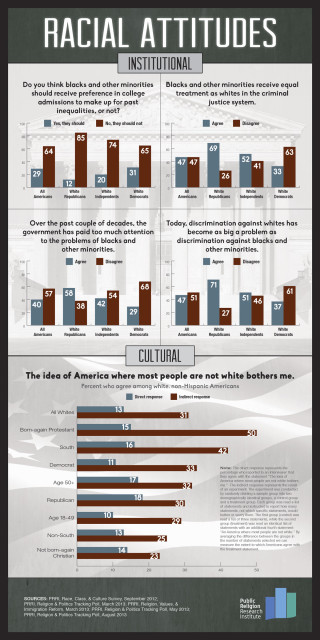As evidenced by the recent public outcry against Donald Sterling and Cliven Bundy, the issue of race still looms large in American society. Not only do attitudes about race divide Americans demographically and culturally, the issue of race also creates substantial political divisions. Nearly 7-in-10 (69 percent) white Republicans believe that blacks and other minorities are treated the same as whites in the criminal justice system. In contrast, more than 6-in-10 (63 percent) white Democrats disagree. Most white Republicans (58 percent) say the government has paid too much attention to the problems of blacks and other minorities, a view that is rejected by more than two-thirds (68 percent) of white Democrats. White Republicans (71 percent) are also much more apt to believe that discrimination against whites—sometimes referred to as “reverse discrimination”—has become as big of a problem as discrimination against blacks and other minorities. More than 6-in-10 (61 percent) white Democrats disagree that discrimination against whites constitutes as big of a problem as discrimination against blacks and other minorities.
However, on one issue there is general partisan agreement: affirmative action in college admissions. Eighty-five percent of white Republicans, 74 percent of white independents and 65 percent of white Democrats believe that blacks and other minorities should not receive preference in college admissions to make up for past inequalities.
When it comes to expressing concern about the changing racial landscape in the U.S., a unique survey experiment reveals that there are actually few differences in the views of white Democrats and white Republicans. When asked directly by an interviewer whether “the idea of an America where most people are not white bothers me,” 11 percent of white Democrats and 18 percent of white Republicans agreed. However, when these views were measured indirectly, white Democrats and white Republicans were about equally as likely to say that “an America where most people are not white” would bother them (33 percent vs. 30 percent).
The survey experiment, commonly referred to as a list experiment, works by randomly dividing the sample into two demographically identical groups, a control group and a treatment group. Each group was read a list of statements and instructed to report how many statements—but not which specific statements—would bother or worry them. The first group (control) was read a list of three statements, while the second group (treatment) was read an identical list of statements with an additional fourth statement: “An America where most people are not white.” By averaging the difference between the groups in the number of statements selected, PRRI is able to measure the extent to which Americans agree with the treatment statement, and, in this case, uncover the tacit anxiety white Americans feel when faced with the changing racial composition of the country.